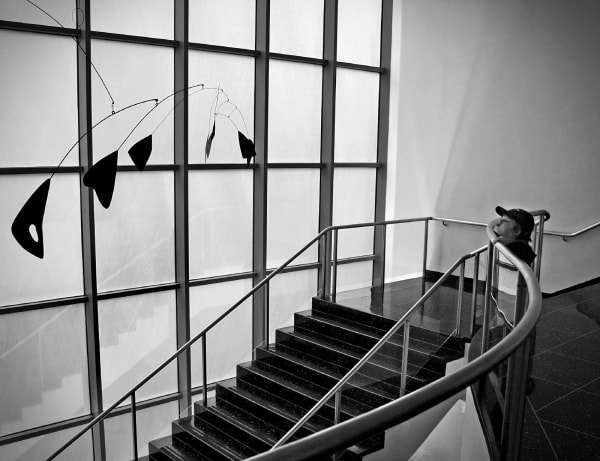Alexander Calder turned 71 in 1969. He was still playful, energetic and continued to create fantastic drawings, paintings, prints and sculptures but, like all humans, Calder had to deal with the events that accompany the aging process.
He lost two of his closest friends, Marcel Duchamp and Ben Shahn, and was beginning to feel the effects of Parkinson’s Disease. It was Duchamp who named Calder’s original works mobiles and who remained a great friend, until Duchamp’s death, in 1968.
For a book put together as an homage to Duchamp after his death, Calder wrote and illustrated a poem about life for his friend:
M. Duchamp
Born like a light
Lived like a light
Out like a light
And that was the delightful life of Marcel Duchamp
The poem does have dark humor, but also reveals Calder’s acceptance of death as a part of life. It was seven years after he wrote the poem that Calder died, in New York, at the home of his daughter, Mary.
Working with Gravity
Calder’s original early mobiles moved with air currents or touch. His later works, although still playful and utilized many of the forms that are so recognizable as Calder, were heavier and more grounded. Called stabiles, the viewer was able to move around the sculpture, rather than stand immobile while the sculpture moved.
His later works changed the way we view public art today. In 1969, the National Endowment for the Arts (NEA) awarded a grant to Grand Rapids, Michigan to create the first public sculpture jointly financed by federal and private funds. It was hoped that the sculpture, to be placed in front of the new city hall, would help to revitalize the downtown area.
When it was announced that Alexander Calder would create a giant, modern red sculpture for Grand Rapids, there was much dissent within the community. The public was used to seeing bronze or stone statues of war heroes or angels (like the great statues created by Calder’s father and grandfather) and not abstract art done in “communist” red.
Calder named the statue La Grande Vitesse, meaning “the great swiftness.” The 43-foot-high statue had a dramatic impact on the city. It energized the community and led to the creation of a civic theater, an art museum and a symphony hall. Images of La Grande Vitesse are ubiquitous in Grand Rapids. They appear on the city’s letterhead, on the side of garbage trucks, on tourism info and about half a million people attend a party to commemorate its unveiling every year.
Calder Originals in Later Life
The same year that La Grand Vitesse was completed, Calder continued to draw and paint. One of the most interesting works that he did in 1969 is Enmeshed Jewel. The shape of the jewel is one that recurs in much of his work but, instead of floating on the paper, it is confined by the lines surrounding it, making it appear more like a religious symbol than the free-floating shapes in his earlier works.
Calder, in later life, produced works, like The Kite That Never Flew, that were larger, more grounded and tethered to the earth than before.
Alexander Calder Originals at Surovek Gallery
Please contact us for more information about Alexander Calder’s Enmeshed Jewel, or any or the other fine works at the Surovek Gallery.



